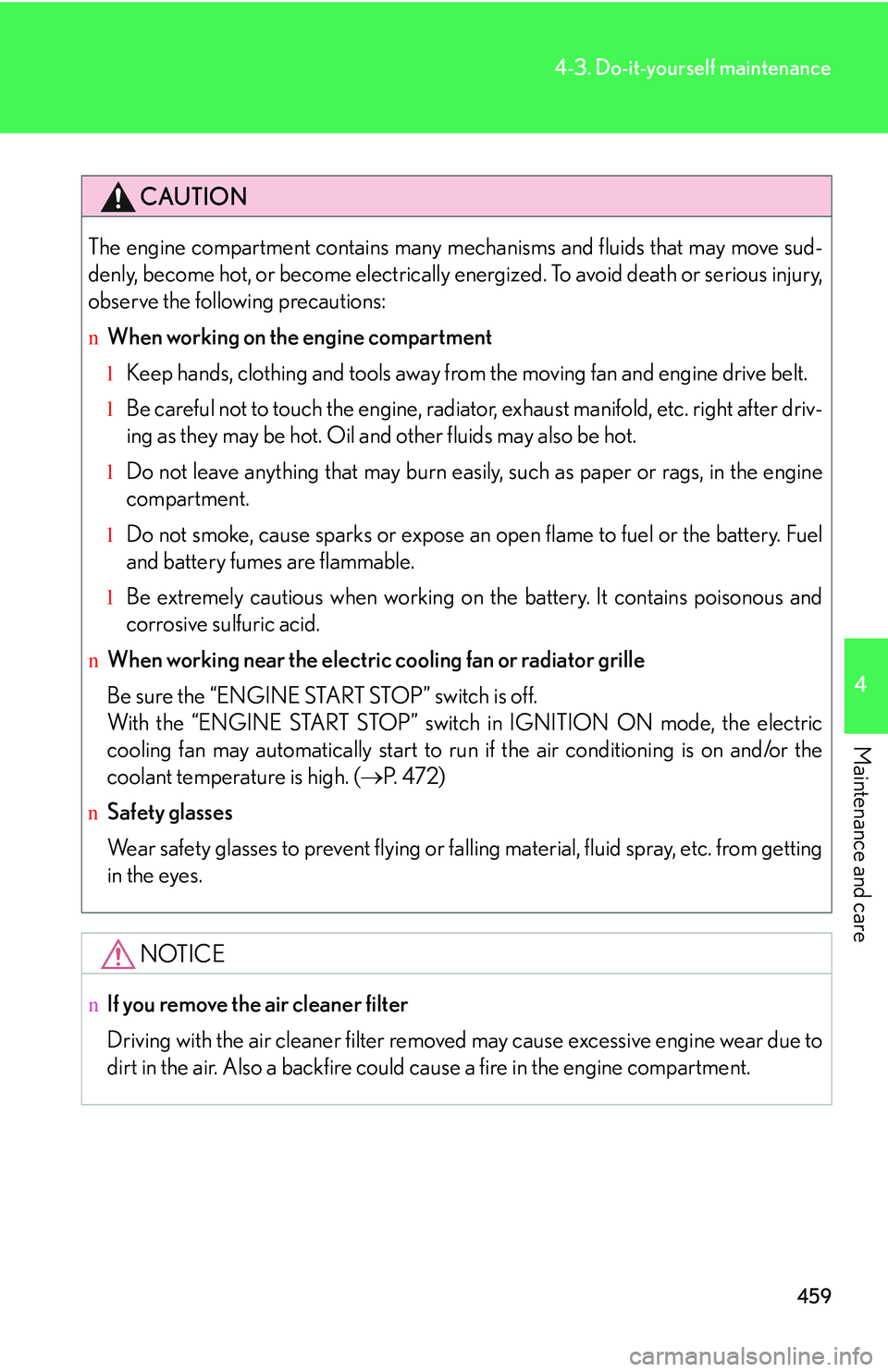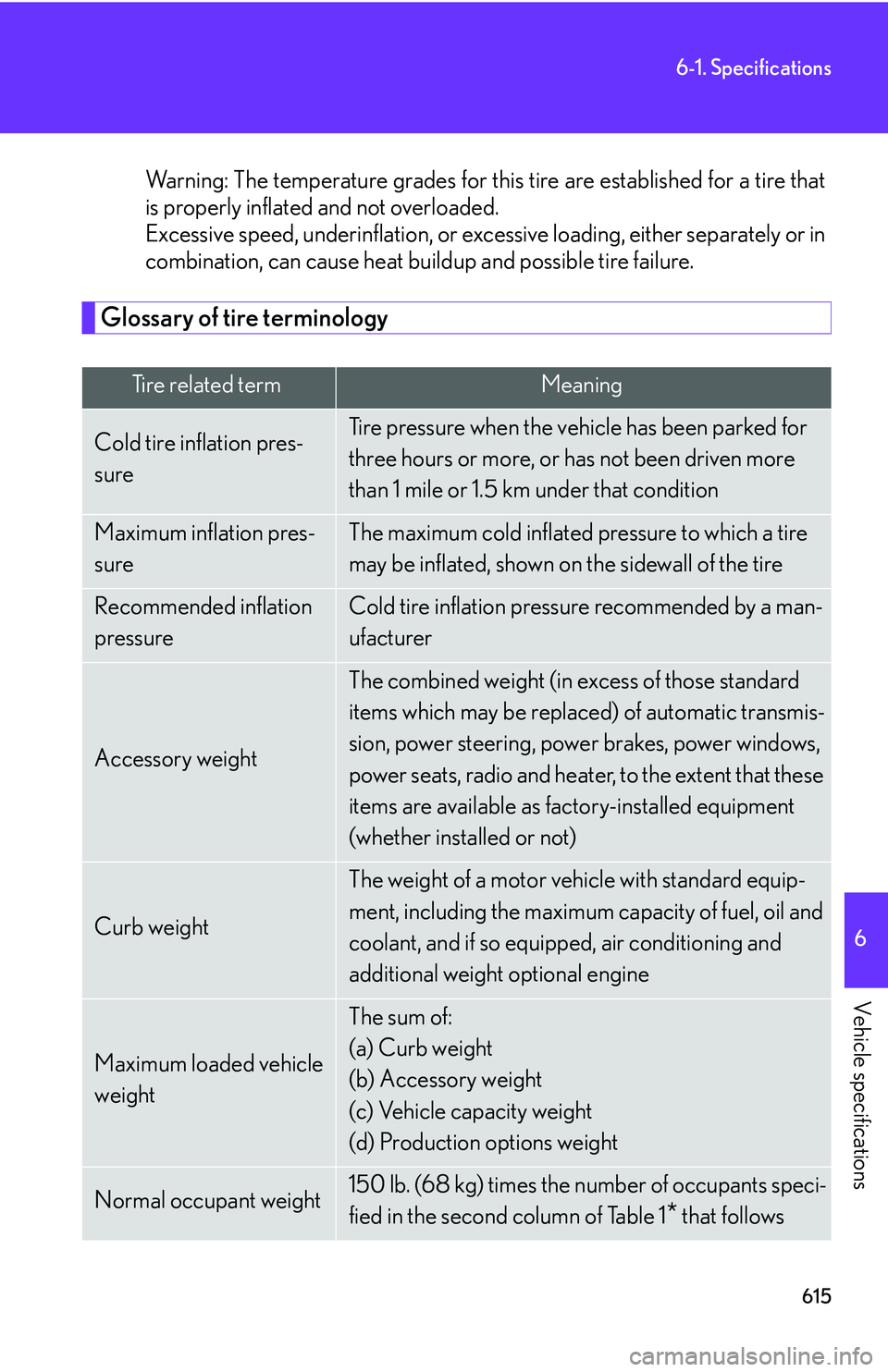oil temperature LEXUS RX350 2011 Owners Manual
[x] Cancel search | Manufacturer: LEXUS, Model Year: 2011, Model line: RX350, Model: LEXUS RX350 2011Pages: 821, PDF Size: 13.27 MB
Page 529 of 821

459
4-3. Do-it-yourself maintenance
4
Maintenance and care
CAUTION
The engine compartment contains many mechanisms and fluids that may move sud-
denly, become hot, or become electrically energized. To avoid death or serious injury,
observe the following precautions:
nWhen working on the engine compartment
lKeep hands, clothing and tools away from the moving fan and engine drive belt.
lBe careful not to touch the engine, radiator, exhaust manifold, etc. right after driv-
ing as they may be hot. Oil and other fluids may also be hot.
lDo not leave anything that may burn easily, such as paper or rags, in the engine
compartment.
lDo not smoke, cause sparks or expose an open flame to fuel or the battery. Fuel
and battery fumes are flammable.
lBe extremely cautious when working on the battery. It contains poisonous and
corrosive sulfuric acid.
nWhen working near the electric cooling fan or radiator grille
Be sure the “ENGINE START STOP” switch is off.
With the “ENGINE START STOP” switch in IGNITION ON mode, the electric
cooling fan may automatically start to run if the air conditioning is on and/or the
coolant temperature is high. (�→P. 4 7 2 )
nSafety glasses
Wear safety glasses to prevent flying or falling material, fluid spray, etc. from getting
in the eyes.
NOTICE
nIf you remove the air cleaner filter
Driving with the air cleaner filter removed may cause excessive engine wear due to
dirt in the air. Also a backfire could cause a fire in the engine compartment.
Page 536 of 821

466
4-3. Do-it-yourself maintenance
Engine oil
With the engine at operating temperature and turned off, check the oil
level on the dipstick.
nChecking the engine oil
Park the vehicle on level ground. After turning off the engine, wait
more than 5 minutes for the oil to drain back into the bottom of
the engine.
Hold a rag under the end and pull
the dipstick out.
Wipe the dipstick clean.
Reinsert the dipstick fully.
Holding a rag under the end, pull the dipstick out and check the
oil level.
Wipe the dipstick and reinsert it fully.
Low
Full
STEP1
STEP2
STEP3
STEP4
STEP5
STEP6
Page 667 of 821

597
6-1. Specifications
6
Vehicle specifications
Lubrication system
nEngine oil selection
“Toyota Genuine Motor Oil” is used in your Lexus vehicle. Use Lexus
approved “Toyota Genuine Motor Oil” or equivalent to satisfy the follow-
ing grade and viscosity.
Oil grade: ILSAC multigrade engine oil
Recommended viscosity: SAE 0W-20
SAE 0W-20 is the best choice for
good fuel economy and good
starting in cold weather.
If SAE 0W-20 is not available,
SAE 5W-20 oil may be used.
However, it must be replaced with
SAE 0W-20 at the next oil
change.
The 0W portion of the oil viscosity rating indicates the characteristic of the oil
which allows cold startability. Oils with a lower value before the W allow for eas-
ier starting of the engine in cold weather.
The 20 in 0W-20 indicates the oil viscosity when the oil is at its operating tem-
perature. An oil with a higher viscosity may be better suited if the vehicle is oper-
ated at high speeds, or under extreme load conditions.
Oil capacity
(Drain and refill �⎯
reference)
With filter6.4 qt. (6.1 L, 5.3 Imp. qt.)
Without filter6.0 qt. (5.7 L, 5.0 Imp. qt.)
Outside temperature
Page 685 of 821

615
6-1. Specifications
6
Vehicle specifications
Warning: The temperature grades for this tire are established for a tire that
is properly inflated and not overloaded.
Excessive speed, underinflation, or excessive loading, either separately or in
combination, can cause heat buildup and possible tire failure.
Glossary of tire terminology
Tire related termMeaning
Cold tire inflation pres-
sure
Tire pressure when the vehicle has been parked for
three hours or more, or has not been driven more
than 1 mile or 1.5 km under that condition
Maximum inflation pres-
sure
The maximum cold inflated pressure to which a tire
may be inflated, shown on the sidewall of the tire
Recommended inflation
pressure
Cold tire inflation pressure recommended by a man-
ufacturer
Accessory weight
The combined weight (in excess of those standard
items which may be replaced) of automatic transmis-
sion, power steering, power brakes, power windows,
power seats, radio and heater, to the extent that these
items are available as factory-installed equipment
(whether installed or not)
Curb weight
The weight of a motor vehicle with standard equip-
ment, including the maximum capacity of fuel, oil and
coolant, and if so equipped, air conditioning and
additional weight optional engine
Maximum loaded vehicle
weight
The sum of:
(a) Curb weight
(b) Accessory weight
(c) Vehicle capacity weight
(d) Production options weight
Normal occupant weight150 lb. (68 kg) times the number of occupants speci-
fied in the second column of Table 1* that follows
Page 724 of 821

655
Alphabetical index
Electric power steering ....................... 231
Electronic features control ................ 173
Electronic key
If the electronic key does not
operate properly ............................. 581
Emergency flasher switch .................524
Emergency, in case of
If the electronic key does not
operate properly ............................. 581
If the engine will not start ................577
If the shift lever cannot be
shifted from P ................................... 579
If the vehicle has a
discharged battery ........................ 584
If a warning buzzer sounds .......... 535
If a warning light turns on .............. 535
If a warning message is
displayed ............................................ 545
If you have a flat tire ........................ 564
If you lose your keys ....................... 580
If you think something is
wrong..................................................... 531
If your vehicle becomes stuck ....590
If your vehicle has to be stopped
in an emergency...............................591
If your vehicle needs to be
towed ................................................... 525
If your vehicle overheats................ 587
Engine
Accessory mode................................. 153
Compartment......................................463
Engine switch ........................................ 153
Hood ....................................................... 460
How to start the engine ................... 153
Identification number ...................... 595
If the engine will not start................ 577
Ignition switch ....................................... 153
Overheating ........................................ 587
Engine compartment cover ............. 464
Engine coolant
Capacity ................................................ 599
Checking ...............................................470
Preparing and checking
before winter ....................................254
Engine coolant temperature
gauge....................................................... 166
Engine immobilizer system..................101
Engine oil
Capacity .................................................597
Checking .............................................. 466
Preparing and checking
before winter ....................................254
Engine oil maintenance data............468
EPS .............................................................. 231
Event data recorder ............................533
E
Page 763 of 821

Evaporative Control System
•Charcoal canister
•Diaphragm valve
•Fuel filler cap
•Fuel tank
•Vapor liquid separator
Exhaust Gas Recirculation
(EGR) System
•EGR gas temperature sensor
•EGR valve
•Associated parts
Ignition System
•Distributor and internal parts
•Ignition coil and ignitor
•Ignition wires
•Spark plugs*
Positive Crankcase Ventilation
(PCV) System
•Oil filler cap
•PCV valve or orifice
Other Parts Used in Systems
Listed
•Data link connector (8/80)
•Hoses, clamps, fittings, tubing
and mounting hardware
•Malfunction indicator light and
bulb (8/80)
•Pulleys, belts and idlers
•Sealing gaskets and devices
•Sensors, solenoids, switches and
valves
Your Warranties in Detail24
FEDERAL EMISSION CONTROL WARRANTY
W ARRANTY
8/80 = Covered for eight years or 80,000 miles, whichever occurs first.*Warranted until first required maintenance under terms of the California Emission Control Warranty.
89577_2011RX350_9-38d_R1.qxd8/6/107:00PMPage24
Page 783 of 821

Scheduled Maintenance Log
SCHEDULED MAINTENANCE LOG
MAINTENANCE
44
Determining Your
Maintenance Interval:
Months vs. Mileage
Lexus recommends obtaining sched-
uled maintenance for your vehicle
every six months or 5,000 miles,
whichever occurs first.
For example:
•If at six months you have driven
less than 5,000 miles, you
should obtain maintenance at six
months; don’t wait until 5,000
miles.
•If you drive 5,000 miles in less
than six months, you should
obtain maintenance at 5,000
miles; don’t wait until six months.
Be sure to keep an eye on your
mileage so that you obtain mainte-
nance when recommended. If you are
a low-mileage driver, mark your cal-
endar to remind yourself to obtain
maintenance every six months.
Special Operating
Conditions
In addition to standard maintenance
items, vehicles that are driven under
special operating conditions require
further maintenance service. These
special operating conditions, which
put added demands on a vehicle,
include:
•Driving on dirt roads or on dusty
roads
•Repeated trips of less than five
miles in temperatures below
32° F or 0° C
•Extensive idling and/or low-
speed driving for long distances,
such as police, taxi or door-to-
door delivery use
If you drive primarily under any
of the conditions noted, you
should replace the engine oil
and oil filter every six months or
5,000 miles. Some of these
special operating conditions
require other maintenance items;
these items are indicated in each
maintenance chart.
89577_2011RX350_39-47b_R1.qxd8/6/107:19PMPage44